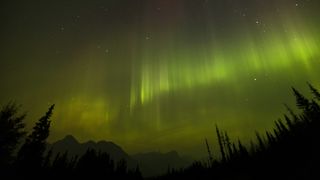Stream of solar wind brings stunning aurora to north American skies
Recent intense solar activity sees bursts of solar plasma hit Earth.

Violent activity on the sun last week resulted in stunning views for observers in the northern hemisphere over the weekend.
A coronal mass ejection (CME) released by the sun on Sept. 2 resulted in a G2-class (moderate) geomagnetic storm on its arrival at Earth on Sunday and spilling over into Monday (Sept. 5), according to NOAA's Space Weather Prediction Center.
Sunday sightings of auroras stretched from New Hampshire to Michigan to Washington in the U.S., highlighted by naked-eye pillars over Yellowstone National Park, according to Spaceweather.com, with watchers reporting stunning and colorful punctuations of their skies.
The displays are the latest in a string of recent events sparked by intense activity on the sun. Our star is working through its 11-year solar cycle which is predicted to bring peak sunspot activity during the solar maximum expected in 2025.
Related: Extreme solar storms can strike out of the blue. Are we really prepared?
Apart from beautiful aurora displays, geomagnetic storms can also cause radio blackouts and, in extreme cases, like the 1859 Carrington Event, could play havoc with technology on Earth. Power grids but also satellites in orbit are especially vulnerable to effects of severe space weather. In February this year, SpaceX lost a batch of 40 brand new Starlink satellites after launching into a relatively mild solar storm. Other operators reported problems maintaining orbits of low-Earth-orbit satellites due to the increased solar activity.
No radio blackouts, which can range from minor to extreme, were reported by NOAA on Sunday however.
Get the Space.com Newsletter
Breaking space news, the latest updates on rocket launches, skywatching events and more!
Look at this green picket fence aurora! 😱 https://t.co/soz35mJaXVSeptember 5, 2022
An Aug. 30 CME hit the European Solar Orbiter days ahead of its Sept. 4 Venus flyby, but the spacecraft suffered no negative effects.
There are currently five sunspot regions on the visible disc of the sun, according to the UK’s Met Office, with sunspot AR3089 being the largest and most complex region.
The Met Office predicts solar activity will be low for the coming few days, with a chance of a few moderate flares from AR3089.
Follow us on Twitter @Spacedotcom and on Facebook.
Join our Space Forums to keep talking space on the latest missions, night sky and more! And if you have a news tip, correction or comment, let us know at: community@space.com.

Andrew is a freelance space journalist with a focus on reporting on China's rapidly growing space sector. He began writing for Space.com in 2019 and writes for SpaceNews, IEEE Spectrum, National Geographic, Sky & Telescope, New Scientist and others. Andrew first caught the space bug when, as a youngster, he saw Voyager images of other worlds in our solar system for the first time. Away from space, Andrew enjoys trail running in the forests of Finland. You can follow him on Twitter @AJ_FI.
